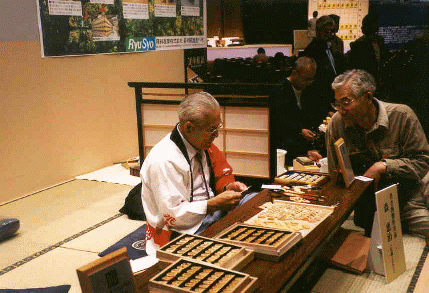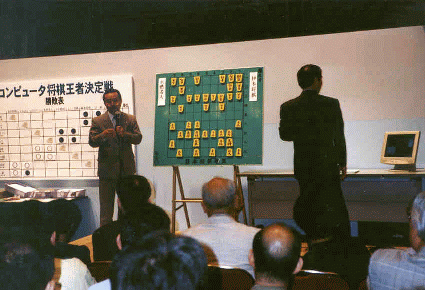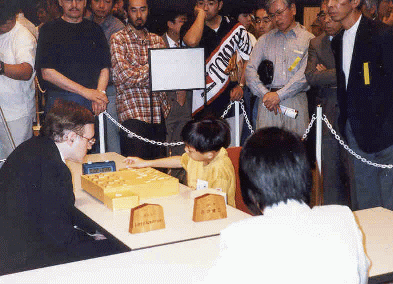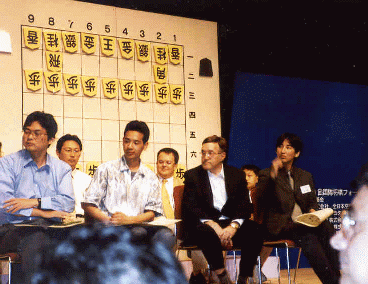The 1st International Shogi Forum
Kokusai Forum, Tokyo
June 19th and 20th 1999
(Photo's kindly provided by Marco Durante. You can find more pictures
here.)
On June 19th and 20th the First International Shogi Forum (ISF) was held in
Tokyo. Judging from the information I got, this was supposed to be a big
event. However, I did not realise how big it was until I arrived in at the
venue in Yurakucho on the morning of Saturday June 19th. The Kokusai Forum
where the ISF was held, was next to the subway station on the busy Yamanote
line and I had passed it many times without ever going in. It turned out to be
much bigger than I expected and I had some serious trouble finding the right
halls inside this immense complex. When I saw a couple of hundred people
lined up in front of one of the halls, for a moment I feared that Shogi might
have gotten a little more popular than I thought and that I would have to
cue up to get in. Then I realised that all people in line were under 30 and
that there must be some other big events going on at the Kokusai Forum at the
same time.
When I found the B wing, I realised that the set-up was much bigger than I
expected. I thought that the International Shogi Tournament (IST) was the main
event with some small side shows. Not true. Even though the International
Shogi Tournament was the main event, there were all kinds of things going
on in three different halls. In the first hall (B-1), there was a big
stage with a huge shogi demonstration board and a couple of hundred seats.
This was the event stage where during the weekend there would be exhibition
games between professionals, a tsume shogi competition, a pair shogi tournament
(pairs of women professionals and players knocked out of the IST) and comments
on games going on in the IST. This was not all, because also in hall B-1 there
was the Computer Shogi Grand Prix, a computer shogi tournament between
the eight best programs of this year's CSA tournament. Furthermore, there
was a small exhibition of old shogi boards and pieces and there was an
exhibition about the production of shogi equipment.

Production of traditional Shogi equipment
In hall B-2 (next to B2 on the 7th floor of wing B), the International
Shogi Tournament was held. This tournament had a set-up that is even rare
at Japanese amateur championships. It had the feel of a top chess grandmaster
tournament. There was one separate table for each game, which was played
with high quality board and pieces. The table was separated from the
spectator area by white chains. Also, at each table someone would write
down the gamerecord. I could not help but feel a little disappointed
that I was not allowed to play in such a great event.
In hall B-2 there was also a corner where shogi-variants like chess and
xiang-qi could be played (^_^), and a shop where shogi goods like books,
fans and playing equipment were being sold. In the lobby between hall B-1
and B-2 there were some computers set up that had shogi software on them
and where it was also possible to play shogi over the internet. Going down
with the escalator to the fifth floor would bring you to the reception
hall where a Shogi symposium was being held on Saturday. The first session
was about the history of shogi, while the second was about computer shogi.
I did see part of the second session with speakers Iida (Shizuoka University),
Morita (Shogi programmer), Matsubara (my boss at ETL) and Habu (famous
professional).
There was so much to see at the International Shogi Forum that I did not
realize until afterwards that there was also a place where professional
players were playing simultaneous games against some 30 opponents. Anyway,
I would not have found the time anyway, since I did not play a single
game myself all weekend. This was a great pity, since I have never seen
so many shogi professionals in one location before, all very willing to
teach non-Japanese players.
During the two days, I basically divided my attention between the Computer
Shogi Grand Prix and the International Shogi Tournament. In the computer
shogi tournament for the first time all programs were required to run on
the same hardware, 300 MHz computers donated by sponsor Fujitsu. This
gave some serious problems as there was no time for testing and the
processors used in these PCs were not the normal Pentium processors.
World Champion Kanazawa Shogi even had to withdraw because it was impossible
to get the program running. Also, Eisei Meijin was forced to play at a much
lower level than normal, resulting in a loss of all games. Even Jeff's
Shotest program had problems, even though in this case it only meant that
the serial connection did not work, so all moves had to be typed in.
The relaxing "sit back and watch" mode of the last CSA tournament was
therefore not possible.

Explanation of a game in the Computer Shogi Grand Prix
In the end the tournament was won by Kakinoki Shogi, edging YSS on SB score
after both players ended with a 4-2 score. Shared third place was for IS
Shogi and KCC (former Silver Shogi) with 3-2 and one draw. Shotest shared
fifth place with Sougin with 3-3 and Eisei Meijin was in last place with
0-6. Kakinoki's first tournament victory should have made him happy, but
he himself did not feel that it was a proper tournament without Kanazawa
Shogi competing. Jeff had a very strange result in this tournament, beating
both Kakinoki and YSS, but blundering away an easy win against Sougin.
Well, still more than eight months until the next CSA tournament....
1st Computer Shogi Grand Prix
| No | Name | 1 | 2 | 3 | 4 | 5 | 6 | 7 | Pt | SB |
| 1 | Kakinoki Shogi | x | 1 | 1 | 1 | 0 | 0 | 1 | 4 | 11 |
| 2 | YSS | 0 | x | 1 | 1 | 0 | 1 | 1 | 4 | 10 |
| 3 | IS Shogi | 0 | 0 | x | 0.5 | 1 | 1 | 1 | 3.5 | 7.75 |
| 4 | KCC Shogi | 0 | 0 | 0.5 | x | 1 | 1 | 1 | 3.5 | 7.75 |
| 5 | Shotest | 1 | 1 | 0 | 0 | x | 0 | 1 | 3 | 8 |
| 6 | Sougin | 1 | 0 | 0 | 0 | 1 | x | 1 | 3 | 7 |
| 7 | Eisei Meijin | 0 | 0 | 0 | 0 | 0 | 0 | x | 0 | 0 |
Then the main event: the International Shogi Tournament. 32 players from
27 different countries had come to Japan to fight for the honour of being
the first winner of this great event (dare we call it a World Championship?).
6 players from Asia, 13 players from Europe, 1 player from the Middle-East,
2 from North America, 3 from South America and 2 from Oceania were divided
into eight groups of four players. The winners and the runners-up of each
group would qualify for the knock-out tournament. For me the winner was
clear: the Japanese Shibu Meijin Hayashi Takahiro is a top class Japanese
amateur player, who reached the final of the amateur Ryu-O last year. When
I met him there, he turned out to be very talkative and relaxed. Even his
English is pretty good, which made him the perfect representative in this
tournament. The question was: who would he meet in the final? Larry Kaufman
was a likely candidate, as was George Fernandez. And how about the two
Chinese Zao and Shu, who were said to be very strong? Or maybe the
"Brazilian" Aoki Mikio, who was presented as 6-dan in the Forum booklet?
European hopes were European Champion Boris Mirnik from Germany and Eric
Cheymol from France.
This is how the groups were divided:
Group A:
++++++++
Cho Ul Cha Korea
Kisliuk Lev Ulianovich Russia
Larry Kaufman USA
Matt Casters Belgium
Group B:
++++++++
Boris Mirnik Germany
Ashigaki Kaoru Japan
Virginia Gonzaga Suzuki Philipines
Marco Durante Italy
Group C:
++++++++
Tanada Mayumi Japan
Robert Miller New Zealand
Fernando Batista Portugal
Shu Jen Don China
Group D:
++++++++
Irina Novikov Israel
Zao Guo Lon China
Alexander Martinoff Paraguay
Carl Johan Nilsson Sweden
Group E:
++++++++
Chai Mee Joon Singapore
Simon Morgan Australia
Alse Olufsen Norway
Niwa Kenji Japan
Group F:
++++++++
Hayashi Takahiro Japan
Les Blackstock England
Almira Scripcenco Moldova
George Fernandez USA
Group G:
++++++++
Eric Cheymol France
Sakurai Naohiko Argentina
Seppo Kalevi Ronkko Finland
Viktor Tyshchenko Ukrain
Group H:
++++++++
Harry Iwata Canada
Wisit Ngaolertloi Thailand
Aoki Mikio Brazil
Marc Theeuwen The Netherlands
I was told the draw of the tournament was weighted to avoid having all strong
players in one group. Still, the difference in strength between different
groups was clear. One has to feel especially sorry for Les Blackstock, a
strong 3-dan player who ended up in a group with Hayashi and Fernandez. In
the end he had to leave the tournament after losing to both these players.
Fernando Batista also was a victim of an unlucky draw. In a strong group
with amateur Ladies Meijin Tadana and the Chinese Shu, he beat Shu
once, but lost the decisive game after both ended up with a 1-1 score.
If these two players would have been in for example group D or group G, I
am sure that they would have qualified easily. European Champion Boris
Mirnik had to struggle hard to make the finals. In the end he had to beat
Ashigaki, a young Japanese girl (13, 14?), twice to secure his place in
the final 16. Especially the second time it seemed that he was hopelessly
lost, but his outstanding defensive skills and a little luck saved the day.
There was a surprising win of Irina Novikov over the Swedish winner of the
British Open Carl Johan Nilsson, which meant that there were no less than
three women among the final sixteen.
Kessho Tournament:
==================
L.Kaufman --
|- Kaufman --
M.Theeuwen -- |
|- Kaufman --
B.Mirnik -- | |
|- Mirnik -- |
E.Cheymol -- |
|- Kaufman --
M.Tanada -- | |
|- Tanada -- | |
G.Fernandez -- | | |
|- Niwa -- |
I.Novikov -- | |
|- Niwa -- |
K.Niwa -- |
|- Hayashi
G.Zao -- |
|- Zao -- |
A.Olufsen -- | |
|- Hayashi -- |
J.Shu -- | | |
|- Hayashi -- | |
T.Hayashi -- | |
|- Hayashi --
V.Suzuki -- |
|- Suzuki -- |
S.Ronkko -- | |
|- Casters --
M.Casters -- |
|- Casters --
M.Aoki --
The knock-out tournament showed some interesting match-ups. Boris Mirnik
played European rival Eric Cheymol and beat him for the first time. Tough
on Eric, who had high hopes for this tournament and cruised through the
preliminary group. The result of Tanada against Fernandez was a big surprise
to me. I have played them both and I feel that George is stronger than
the two times amateur women's Meijin. In the other half of the draw, the
Chinese will not have been too happy. Shu and Zao played Hayashi in
consecutive rounds and both were unable to knock out the favourite.
Belgian star Matt Casters showed that a Brazilian 6-dan can still
learn some tricks from an European 3-dan and advanced to the final eight.
In the quarterfinals Kaufman beat Mirnik in a game that was very one-sided
for a long time, but became quite close in the end. When Boris missed a
good chance (his only one), his tournament run was over. The battle of the
Japanese between Tanada and Niwa was decided in the favour of little Niwa,
the Japanese elementary school champion. In the other half Hayashi beat
Zao and Casters advanced by beating Suzuki, knocking out the last woman
player.

Semi-final between Kaufman and Niwa
No excitement in the semifinals where both Kaufman and Hayashi showed that
they were the two strongest players in this tournament. I expected that the
final would be just as one-sided with an easy win for Hayashi. At first it
looked that way, with Hayashi getting a pawn in hand with natural piece
development. However, a knight sacrifice followed by a well-timed edge
attack brought Larry back in the game. A gold drop far away from the king
by Hayashi, which was critizised by the commenting professionals even
allowed him to break into Hayashi's camp and suddenly it seemed that the
Japanese was fighting for his life. I am sure that Larry missed a win in
byoyomi, but in the end some shrewd endgame play won the game for Hayashi.
I hope Larry can give his comments on the game some day. The moves of
the final game are given below.
So, in the end this great event got the expected winner. Larry was a little
disappointed that he was not able to make history and that he had to settle
for "best of the rest". Maybe next time, since this event is supposed to be
held every two years. I am already looking forward to the 2001 International
Shogi Forum.

Winners and Runners-Up. Front row left to right Kakinoki (Kakinoki Shogi),
Yamashita (YSS), Kaufman and Hayashi.
The Final:
==========
Black: Larry Kaufman, USA
White: Takahiro Hayashi, Japan
1st International Shogi Tournament, June 20th 1999
1.P7g-7f 2.P3c-3d 3.P6g-6f 4.S7a-6b 5.R2h-6h 6.P6c-6d 7.S7i-7h 8.S6b-6c
9.K5i-4h 10.S6c-5d 11.S7h-6g 12.R8b-6b 13.B8h-7g 14.K5a-4b 15.K4h-3h
16.K4b-3b 17.G6i-5h 18.P7c-7d 19.P5g-5f 20.G6a-5b 21.S3i-4h 22.P1c-1d
23.P1g-1f 24.P4c-4d 25.P4g-4f 26.P4d-4e 27.P4fx4e 28.S5dx4e 29.S4h-5g
30.S4e-5d 31.P*4f 32.S3a-4b 33.G5h-4g 34.S4b-4c 35.P3g-3f 36.G4a-4b
37.G4i-4h 38.S4c-4d 39.N2i-3g 40.G5b-4c 41.R6h-6i 42.N2a-3c 43.B7g-9e
44.P8c-8d 45.R6i-7i 46.P9c-9d 47.B9e-6h 48.R6b-7b 49.B6h-8f 50.S5d-6c
51.P4f-4e 52.N3cx4e 53.N3gx4e 54.P8d-8e 55.N4ex5c+ 56.G4cx5c 57.B8f-6h
58.S6c-5d 59.P1f-1e 60.P1dx1e 61.P*1d 62.K3b-4c 63.L1ix1e 64.P*1b
65.P2g-2f 66.K4c-5b 67.P2f-2e 68.B2b-3c 69.R7i-1i 70.P*4e 71.P1d-1c+
72.P1bx1c 73.P*1b 74.L1ax1b 75.N*2f 76.N*1d 77.L1ex1d 78.P1cx1d
79.N2fx3d 80.G4b-4c 81.P2e-2d 82.P2cx2d 83.N*3e 84.S4dx3e 85.P3fx3e
86.N*2c 87.G4g-3f 88.G5c-4d 89.P*1c 90.G4dx3e 91.G3fx3e 92.N2cx3e
93.P1cx1b+ 94.L*3f 95.K3h-4i 96.P*3g 97.R1ix1d 98.P3g-3h+ 99.K4i-5h
100.L3f-3g+ 101.G4hx3h 102.+L3gx3h 103.P*4d 104.B3cx4d 105.R1dx2d
106.G*8h 107.R2d-2a+ 108.P*5a 109.L*5e 110.S5dx5e 111.P5fx5e
112.P4e-4f 113.S5gx4f 114.P*4g 115.P*4i 116.+L3hx4i 117.K5h-5g
118.P4g-4h+ 119.+R2a-3b 120.P*4b 121.N3dx4b+ 122.G4cx4b 123.S*4c
124.K5b-6a 125.S4cx4b+ 126.N*3c 127.+S4bx5a 128.K6ax5a 129.+R3bx7b
130.P*5f 131.K5gx5f 132.S*4g 133.K5f-5g 134.+P4h-5h Resigns



